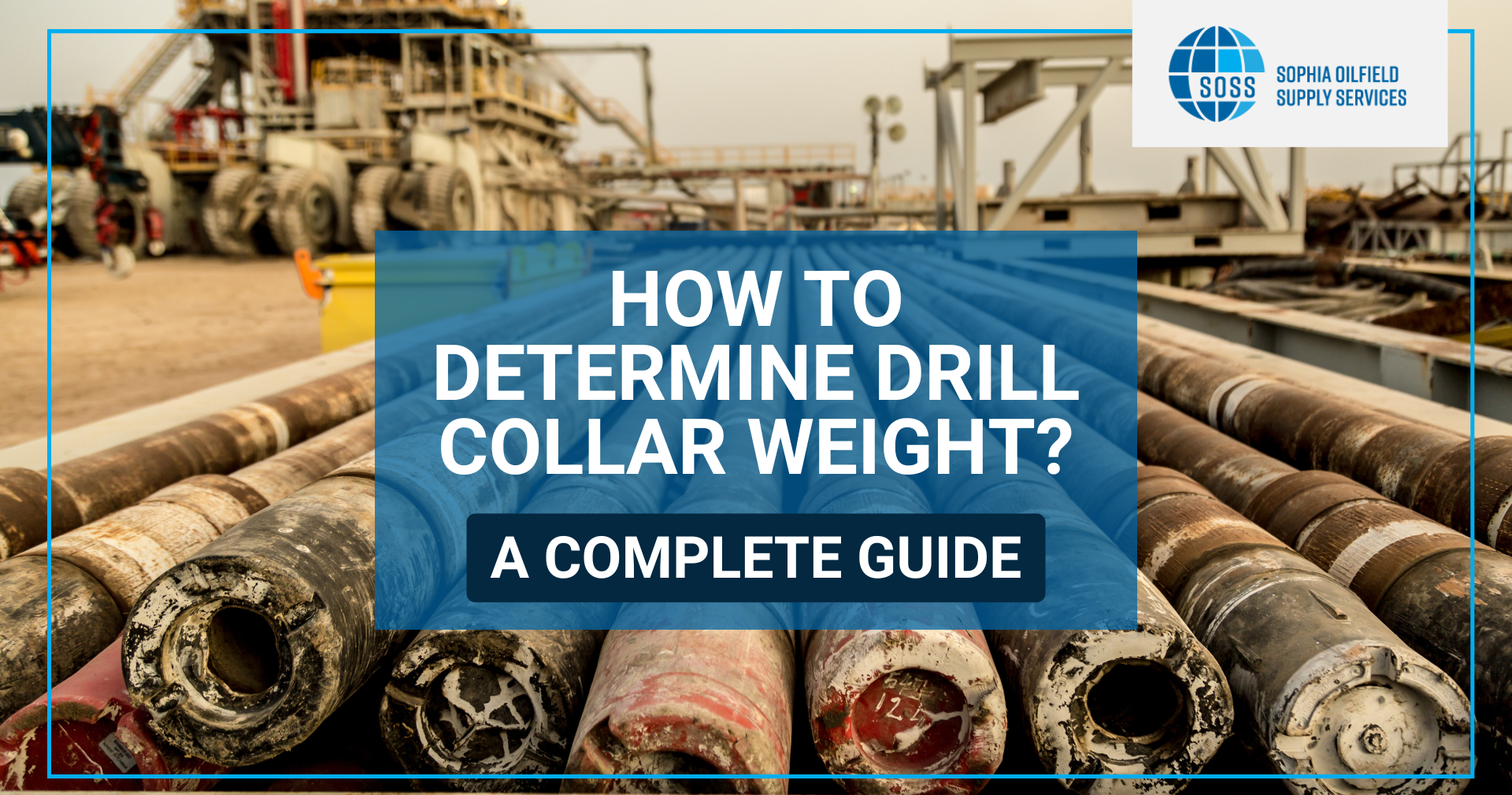Determining the appropriate weight of drill collars is a crucial aspect of drilling operations in the oil and gas industry. The weight of drill collars is important for maintaining the desired pressure on the drill bit, providing stability to the drill string, and ensuring they match the desired weight specifications. Sophia Oilfield Supply Services is a distinguished provider of oilfield products, equipment, and services.
General Overview of Drill Collar Weights
Drill collar weight is a critical factor in drilling operations that involve the use of heavy cylindrical steel components called drill collars. These collars are part of the drill string, the assembly of interconnected drilling tools used to extract oil or gas from underground reservoirs.
In simple terms, drill collar weight refers to the downward force exerted by these heavy steel tubes. The right amount of buoyed weight is crucial to keep the drill bit engaged with the rock formation, ensuring efficient drilling and preventing the drill string from getting stuck. Sophia Oilfield Supply Services (SOSSUSA) is a Premier Distributor of new and used drill pipe, tubing and drilling equipment.
Importance of Determining the Right Drill Collar Weight
Determining the right drill collar weight is a key factor in maintaining stability during drilling, preventing vibrations, and ensuring that the drill bit stays securely engaged with the rock formation. The stability achieved through proper drill collar weight not only enhances drilling efficiency but also minimizes the risk of the drill string getting stuck in the wellbore, reducing downtime and potential complications.
Additionally, understanding different drill collar sizes is crucial, as selecting the correct size is essential to ensuring the appropriate weight and maintaining wellbore integrity.
Moreover, the impact of drill collar weight extends to equipment longevity, as the correct weight minimizes wear and tear on drilling tools, leading to extended equipment lifespan and reduced chances of unexpected breakdowns.
Factors Affecting Drill Collar Weight
Several factors influence the determination of drill collar weight in drilling operations. These factors play a crucial role in ensuring the stability and effectiveness of the drilling process.
Formation Characteristics: The type and characteristics of the rock formation being drilled significantly impact drill collar weight. Harder formations may require more weight to penetrate effectively, while softer formations might demand less. Understanding the geological properties helps in tailoring the drill collar weight to the specific conditions encountered during drilling.
Drilling Fluid Properties: The properties of the drilling fluid circulating in the wellbore influence drill collar weight. The density and viscosity of the drilling fluid affect the buoyancy and pressure exerted on the drill collar. Weight adjustments may be necessary to account for variations in drilling fluid properties, ensuring proper control and stability.
Wellbore Conditions: The conditions within the wellbore, such as its diameter and inclination, impact the required drill collar weight. A larger wellbore or an inclined angle may necessitate adjustments to the weight for optimal stability. Changes in wellbore conditions during drilling operations need to be considered to maintain effective control.
Accurate consideration of these factors is essential for determining the right drill collar weight, optimizing stability, and ensuring the success of drilling operations.
Steps to Determine Drill Collar Weight
Determining the correct drill collar weight involves a systematic approach that considers various factors. Here are the steps to determine drill collar weight:
Gather Necessary Information: Collect well data, including information on the geological formation being drilled. You must also consider data on the drilling fluid properties, such as density and viscosity. Take into account wellbore conditions, including diameter and inclination.
Calculate Effective Weight: Use the gathered information to for knowing the drill collar weight calculation. Also, consider the hardness of the rock formation, adjusting the weight accordingly. Factor in the properties of the drilling fluid to determine the appropriate downward force.
Consider Safety Factors: Use safety margins to account for unexpected changes or uncertainties in good conditions. Further, ensure that the calculated weight provides a robust margin of stability to prevent issues during drilling.
Monitor and Adjust During Drilling: Continuously monitor drilling parameters and conditions in real-time. Also, be prepared to adjust the drill collar weight as needed based on changing geological or operational conditions.
Use Weight Indicators and Measurements: You must utilize weight indicators on the drilling equipment to gauge the applied force. Use downhole measurements to assess the actual downhole conditions and make necessary adjustments.
Review and Refine: Regularly review drilling performance and assess the effectiveness of the applied drill collar weight. Refine the weight calculations based on the ongoing drilling experience and data feedback.
Tools and Techniques for Measurement of Drill Collar Weight
Measuring drill collar weight involves the use of various tools and techniques to ensure accurate and real-time monitoring. Here are some common tools and techniques employed in the oil and gas industry:
Weight Indicators:
Description: Weight indicators are instruments attached to the drilling rig that measure the drill bit weight.
How it Works: These indicators typically use hydraulic or electronic systems to gauge the force exerted on the drill string, providing a readout of the applied weight.
Downhole Measurements:
Description: Downhole tools are sensors or instruments placed near the drill bit to measure conditions directly at the drilling point.
How it Works: Downhole measurements can include tools that monitor weight, torque, and vibration at the drill bit, providing real-time data to guide adjustments in drilling pipe parameters.
Load Cells:
Description: Load cells are devices integrated into the drilling tool joint assembly to measure applied forces.
How it Works: Load cells use strain gauge technology to convert mechanical force into an electrical signal, allowing for precise measurement of the weight on the drill collar.
Drilling Data Recording Systems:
Description: These are comprehensive systems that record and analyze various drilling parameters, including mud weight on bits(WOB).
How it Works: Drilling data recording systems collect data from sensors and instruments throughout the drilling hole process, providing a detailed log for analysis and optimization.
Drill collar string total weight is a fundamental element in drilling operations, directly impacting stability, efficiency, and safety. Accurate determination of this weight, length considering geological factors, and employing real-time monitoring tools, ensure optimal drilling performance. Always follow industry best practices, and consult with drilling experts to ensure the best results from the drilling operation. SOSSUSA.com ensures optimal drill pipe care and handling solutions, maximizing efficiency and longevity in the oil and gas industry.

